Lilac color in the interior

For some, the lilac color is associated with spring, the smell of lilac and lavender, tenderness, romance, for others - with coldness, bombast, for others - with luxury, elegance. Why is the same color perceived differently, how to use it to match your character and beautifully combine with other colors in the interior? It's time to talk about beautiful lilac.

Peculiarities
Take advantage of the ultimate guide for all color professionals - Itten's color wheel. It clearly shows what place lilac takes and why it is often confused with purple. Although many people write that there is more red in lilac and more blue in purple, this is not entirely true. Purple, being one of the 7 main colors, has its own shades: add black paint, and you get shades of the color of eggplant and blueberries, but if you mix purple with white (not red!), You get lilac. The same effect can be achieved by mixing pink and blue.

So, we have dealt with chemistry, now with psychology. Despite the slight difference in the palette, purple and lilac act on a person in different ways: more saturated purple in large quantities has a rather depressing effect on a person. But lilac, especially in pastel shades, calms and relaxes. Purple, not diluted with other colors, the interior will play against the designer. Lilac is much softer and more relaxed.

The color of a spring flower means very different character traits, psychological categories: a creative approach to any business (creativity) and vigilance, perseverance and mystery, a bright future and consistency, nostalgia and patience. But know that if you choose this color for your interior, then your guests, savvy in color psychology, will be able to read in shades that you are vain and dependent, distrustful and secretive, restless and infantile.



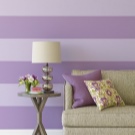


This color is rarely found in nature, which may be why it is considered exquisite. A feature of purple, and with it all shades, including lilac, lavender, is that it is a derivative of hot reds and cold blues. Therefore, saturation on one side or the other makes the tone cool or warm. This saturation will determine in which interior you can use it, and where it is better to abandon the selected shade.
For example, it is believed that the lilac bedroom is the refuge of a lonely person. But, perhaps, the accents were simply incorrectly placed and the shades were chosen.




Shades
The color, named after the flower, just like lilac, has different shades. That is why we can see different subtones, call them lilac, although they are not. For example, the color of lilac itself has a second name - lilac, which can be called classic. The color palette of shades of the classic color includes both pale lilac and pale lilac, wisteria and violet, light lilac and gray-lilac. The color scheme of lilac, lavender, violet, wisteria is close and can be washed out and pale or saturated and bright. Pale shades often turn into silver or pearlescent, more saturated ones - into amethyst, blue-lilac, cyclamen.




To figure out which shades are most compatible and suitable for a particular interior, it is very convenient to use various programs such as AdobeColorCC or ready-made color schemes and tables developed by professionals (for example, photographer Alex Romanuke).
Combinations with other colors
To find beautiful combinations with other colors, distinguish between pale, rich and bright lilac.
- Pale white-lilac best combined with shades from its own circle according to Itten's model: beige, apricot, cream, mint shades, pale blue, that is, what is meant by the concept of "white pastel".




- Saturated lilac goes well with light green, blue, light yellow, bright pink, peach, purple. To create an exquisite interior, combinations with golden, brown, blue, purple, cherry are used.




- Lilac goes well with bright yellows and reds; gray and black are perfect for this shade.




Absolutely all shades are combined with crystal white... To create a warm range, use milky white. Pink-lavender shades, depending on their quantity, can decorate the room of a little fairy, a teenage girl, a self-sufficient adult girl. Lilac with gray is a combination that demonstrates masculine and feminine principles, reliability, confidence, stability. Delicate lilac with golden, lemon, yellow complement each other successfully. By finding a balance between these shades, you can create a very harmonious interior.
Lilac with purple could look hard, with red it could be dangerous and aggressive, but with the right ratio with the predominance of delicate lilacs or the addition of green, pistachio, the room ceases to be heavy and becomes cozy and homely.

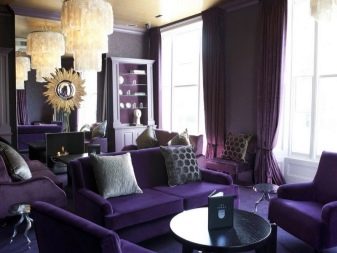


But don't use more than 4 subtones of the same color. And not everyone can choose more than 3 colors in the interior. Fortunately, there are also special color schemes for this, based on the color wheel.
Use in the design of rooms
It is good not only to create an interior with the color of lilac and lavender, but also to decorate it using curtains, vases, a blanket, natural and artificial flowers, pillows, toys, panels, a sofa - a bright accent, a noticeable detail. In small quantities, the color can be more saturated. But if the area of the color is larger, then it needs to be muted: the bed, walls, kitchen set, either use pastel colors, or combine with pastel shades of other colors.
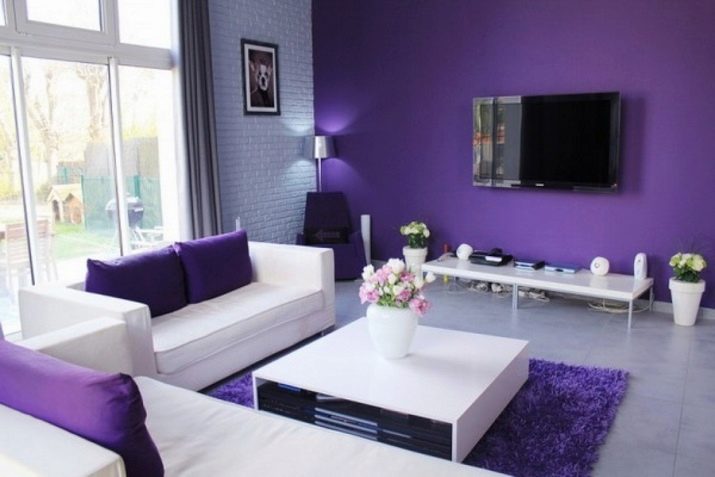





Particular attention should be paid to the ceiling: the smaller the area of the room, the lighter it should be, otherwise it will be psychologically difficult to be in this room. But light colors, on the contrary, can make a room brighter and visually enlarge. But in the interior of each room of the house, you need to choose your own color combination with lilac.
Children
Lavender, violet, rich lilac - even if only panels with these shades hang in the nursery - this is already good, because these are the colors of childhood and adolescence. By the way, lilac relieves fears at a subconscious level. Delicate floral shades are best combined with pink, lemon for girls and blue, beige, yellow, pistachio for boys. But nurseries for newborns are very often decorated in a white and lilac color.




A feeling of tenderness for a girl's room can be created using airy tulle... A guy's room can be furnished with more austere furniture, put a pillow chair on the floor, or hang a poster in this color scheme. Since color is responsible for creativity, it should contribute to the mental and creative activity of children.
And in any case, it will be useful to combine with shades of delicate greens - with the color of calming and relaxation.
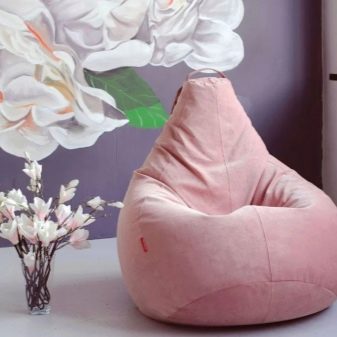

Hallway
The choice of color for the hallway depends on its size: a small entrance room should be the least vulnerable to dirt and defects. Therefore, it is better not to use pure lilac tones on the walls in such a room. Let it be decorative elements or wallpaper, where this color is secondary. But in large hallways, a very interesting design can be obtained in combination with brown or beige furniture.
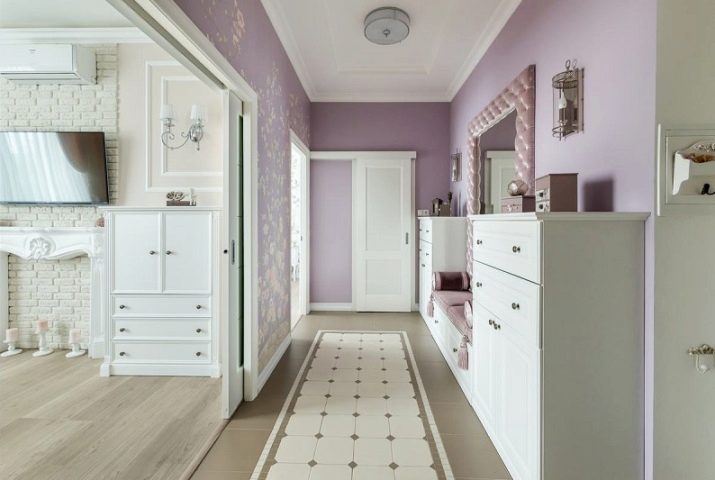





Bathroom
Where, if not in the bathroom, can you smell lavender or lilac? And where there is a smell, there is a color. Wall and floor tiles can contain a pattern with a branch of lilac or mountain lavender. And in fact, and in another case, it will most likely be green as an additional, and this will have a relaxing effect. But the marbled tile looks no worse against the background of monochromatic lilac walls. But the room should not be dark, because this is a place of solitude and relaxation. Or a rich lilac glossy ceiling can be lightened with built-in spotlights, good lighting. The dark tone of lilac in the bathroom can be set off with blue or turquoise sconces, pistachio sinks or bathtubs. In a small bathroom, you should not choose bright red-orange shades.
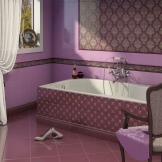
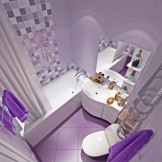


Living room
Depending on the style chosen, as well as the degree of illumination, darker tones can be chosen for the hall. The lighter the room, the darker the shade can be. And although lilac is a self-sufficient color, in a large room it will be more interesting to look at the palette of its shades or in combination with companions. For any age and gender, you can choose an interesting design option. If you are afraid of drastic solutions in the form of wallpaper and ceilings, then try to start with less - a picture, a carpet, lamps.






Due to the texture of textiles, the living room can turn out to be soft, tender, caring, good-natured or formal, cool, arrogant. If desired, such decorative elements can be unusually combined. The main thing is that the set of shades and their saturation are balanced.
It is important to remember that a large amount of purple and lilac will make the room psychologically difficult, shades of lilac will turn the room into an empty space. To prevent this from happening, it is better to compile a light scale with sand, beige, nude, blue, pistachio.




Bedroom
This room is the most popular place in the house, which is why it should be relaxing, not depressing. There should be no feeling of melancholy. But if the room faces the sunny side, then lilac with a bias to blue will make it visually cooler. Often, point decor in lilac tones is chosen for the bedroom: a bedspread, wallpaper on one wall in the form of a panel, wall sconces, paintings, dummies, tulle or curtains. Wallpaper or bed linen in a light lilac floral palette will look great. A small amount of bright purple and green will make the overall look more expressive.
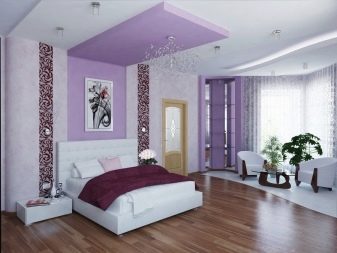



If there is little light in the room, take light yellow as companions as curtains, furniture, decorative elements.
Kitchen
For the kitchen, shades of lilac are not the most traditional, but an unusually beautiful color. The feeling of spring and the smell of flowers will accompany such a kitchen. A combination with green, orange, yellow will be beneficial. A special chic will be a white and lilac kitchen set or a black and lilac kitchen. Depending on the selected style, the colors can be monochromatic or in a small (large) pattern. Lilac is believed to suppress appetite. If one of the family members is watching their weight, hang a picture in front of his place, a photo wallpaper in lilac tones. In small kitchens, you should not make a dark lilac ceiling, and indeed use dark shades.
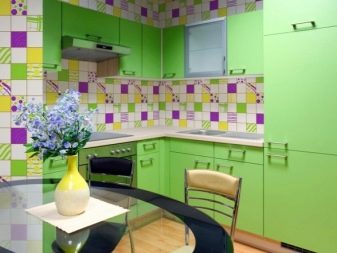


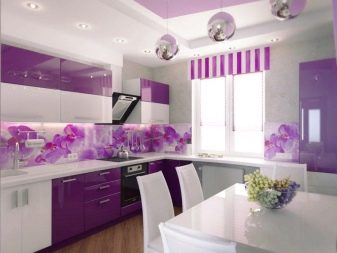
Styles
Different shades of lilac suit many styles.
- V Art Deco the dark tone is ideal for chocolate, diluted with a gold finish. Silver will become a lavender companion.
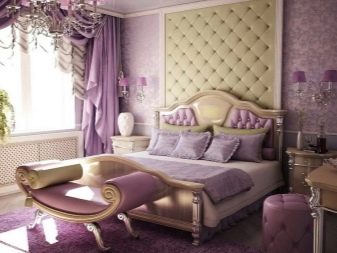
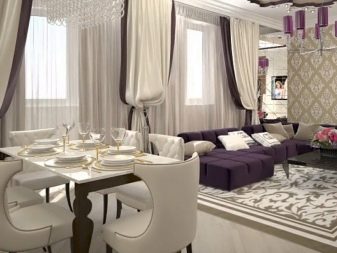
- V boho absolutely not worth thinking about a competent combination of shades. The style motto is “comfort and self-expression”. And all of these concepts are very individual.


- For classicism this is a very suitable color. It will be in good harmony with ivory, beige, milky, cream. Flowers and stripes are appropriate, green trim.
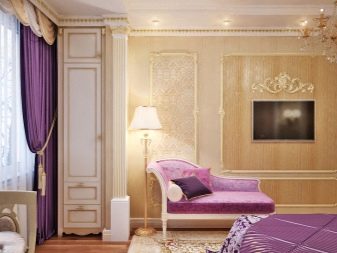

- Contemporary - the simplicity and functionality of minimalism with the grace and coolness of hi-tech makes the interior elegant. Even if it is a very small room.


- Minimalism extravagance and brightness are alien. Light shades with light green, blue, gray are appropriate.


- Modern... Its main idea is dynamic balance, so here colors, shapes, material, texture should balance each other. It is Art Nouveau that often uses bright accents in its interior.


- Provence with lilac, it seems, were always together. Delicate shades, natural aging, natural textiles, simplicity and grace - these are the characteristics of the style. Suitable for any room, but more commonly used in the kitchen.


- Fusion - bohemian luxury behind simplicity. A variety of textures, colors, materials allows you to mix everything with everything. But this seeming chaos of mutually exclusive details finds its balance and harmoniously combines in the interior. Fusion is a trend in modern fashion.


- Futurism Is the style of the future, born in the past. Associations with spaceships, non-standard shapes, dynamic forms, the latest materials. A variety of colors, a lot of white, beige, silver. And lilac easily harmonizes with these flowers.


- Shabby chic - a style artificially created at the end of the 20th century. It is often compared to Provence. But the difference is that Provence loves grandmother's things, real or aged. Shabby chic loves aristocratic antiques. There can be no gilding in Provence, while shabby chic adores it.


Original examples
Not everyone can create real harmony in such a complex space. Honor and praise to the designer who brought this idea to life. The burgundy bedspread and wall trim were intermediate between the lilac ceiling and the brown floor. In another zone, the green color of the plants became the barrier between the lilac partition and the brown furniture legs. It seems that a door is knocking out of this story, but the decorator probably has an explanation for this.
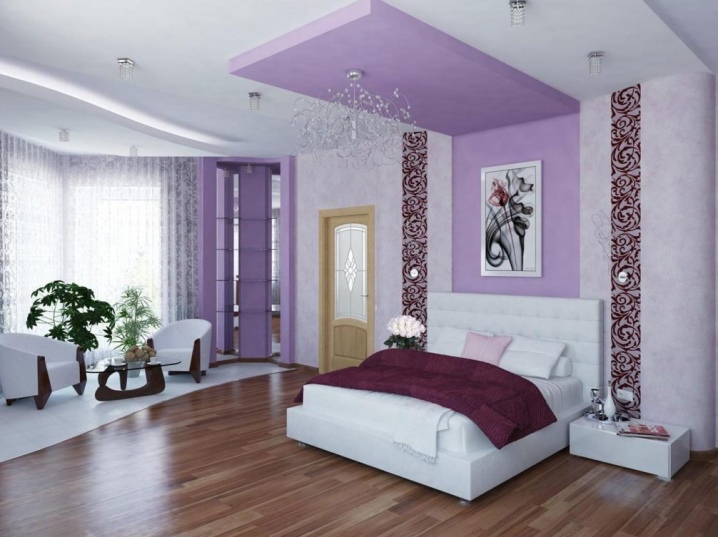
Here is the case when the balance between shades is respected. If the ceiling were a little darker, then the room would look darker, more fragmented. Now all the colors complement each other, leaving room for space and thoughts. Ideas with such a plot for photo wallpapers in this interior are really original: lilac, olive, pistachio tune for the future, autumn foliage always symbolizes the outgoing.

Despite the fact that the main color of the bedroom is lilac, due to the competent illumination it becomes silvery. A very interesting lighting idea, coupled with the reflective surface of the cabinet, caused the color to disintegrate into many shades.
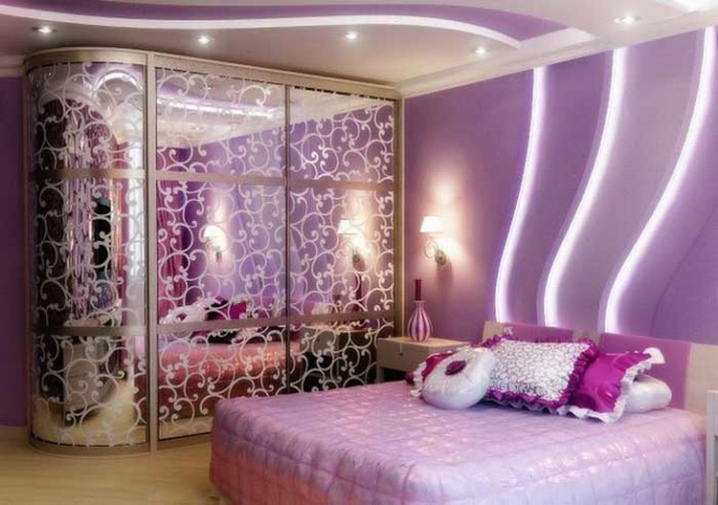
For information on how to properly decorate the interior in lilac color, see the next video.













Thanks for the useful information! Lilac is the "younger brother" of purple, the color of higher spirituality, mysticism, imagination and inspiration. It is also the color of the crown chakra, also called the thousand-petalled lotus.
The comment was sent successfully.